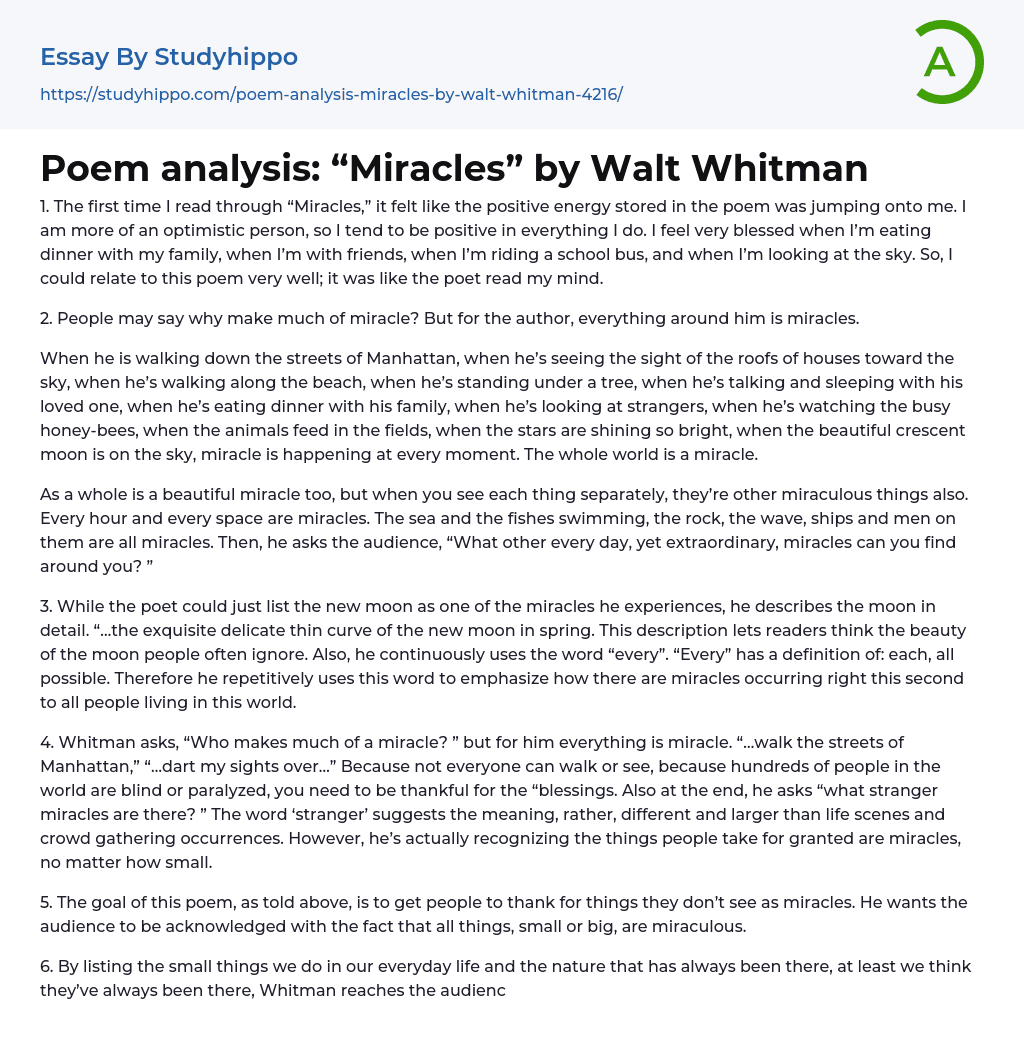1. The first time I read through “Miracles,” it felt like the positive energy stored in the poem was jumping onto me. I am more of an optimistic person, so I tend to be positive in everything I do. I feel very blessed when I’m eating dinner with my family, when I’m with friends, when I’m riding a school bus, and when I’m looking at the sky. So, I could relate to this poem very well; it was like the poet read my mind.
2. People may say why make much of miracle? But for the author, everything around him is miracles.
When he is walking down the streets of Manhattan, when he’s seeing the sight of the roofs of houses toward the sky, when he’s walking along the beach, when he’s standing under a tree, when he’s talking and sleeping with his
...loved one, when he’s eating dinner with his family, when he’s looking at strangers, when he’s watching the busy honey-bees, when the animals feed in the fields, when the stars are shining so bright, when the beautiful crescent moon is on the sky, miracle is happening at every moment. The whole world is a miracle.
As a whole is a beautiful miracle too, but when you see each thing separately, they’re other miraculous things also. Every hour and every space are miracles. The sea and the fishes swimming, the rock, the wave, ships and men on them are all miracles. Then, he asks the audience, “What other every day, yet extraordinary, miracles can you find around you? ”
3. While the poet could just list the new moon as one of the miracles he experiences, he
describes the moon in detail. “…the exquisite delicate thin curve of the new moon in spring. This description lets readers think the beauty of the moon people often ignore. Also, he continuously uses the word “every”. “Every” has a definition of: each, all possible. Therefore he repetitively uses this word to emphasize how there are miracles occurring right this second to all people living in this world.
4. Whitman asks, “Who makes much of a miracle? ” but for him everything is miracle. “…walk the streets of Manhattan,” “…dart my sights over…” Because not everyone can walk or see, because hundreds of people in the world are blind or paralyzed, you need to be thankful for the “blessings. Also at the end, he asks “what stranger miracles are there? ” The word ‘stranger’ suggests the meaning, rather, different and larger than life scenes and crowd gathering occurrences. However, he’s actually recognizing the things people take for granted are miracles, no matter how small.
5. The goal of this poem, as told above, is to get people to thank for things they don’t see as miracles. He wants the audience to be acknowledged with the fact that all things, small or big, are miraculous.
6. By listing the small things we do in our everyday life and the nature that has always been there, at least we think they’ve always been there, Whitman reaches the audience easily. And by explaining and giving details to the small things that wasn’t very extraordinary in our lives, the author lets audience think deeper about those things. Whitman uses the word “or” continuously to emphasize the strong verbs. Verbs like “dart” and “wade”
suggests very vivid and lively language. Also, he tries to address the opening question with his observation that the commonplace and conversation with someone he loves are miracles. He uses “hives,” “streets,” “table at dinner” as the examples of the common places.
7. Whitman frequently uses imagery in his poem to accomplish is goal. “Wade with naked feet along the beach just in the edge of the water” and “the exquisite delicate thin curve of the new moon in spring” are examples of imagery. He also uses repetition for rhythm of the poem. The word “or” and “every” begin the most of the lines of this poem. He uses a list poem as the form of this work. By adding vivid language, repetition, deliberate structure and enthusiastic sound, he makes this poem come alive.
8. The form of this poem is a list. He opens by asking a rhetorical question “why, who makes much of a miracle? ” He addresses the question but not answer it in between. At the end, another rhetorical question is asked, “What stranger miracles are there? ” He doesn’t answer the question purposely in order to let audience think of other miraculous things that can be found in everyday life.
- Book Summary essays
- Metaphor essays
- Reader essays
- Rhyme essays
- Literary devices essays
- Villain essays
- Books essays
- Genre essays
- Literary Criticism essays
- Writer essays
- Protagonist essays
- Simile essays
- Poem essays
- Book Report essays
- Book Review essays
- Greek Mythology essays
- Plot essays
- Tragic Hero essays
- Coming of Age essays
- Play essays
- Rhetoric essays
- Rhetorical Question essays
- Translation essays
- Understanding essays
- Reason essays
- Character essays
- Letter essays
- American Literature essays
- Literature Review essays
- Utopia essays
- Poetry Analysis essays
- Dante's Inferno essays
- Between The World and Me essays
- Incidents in The Life of a Slave Girl essays
- Flowers for Algernon essays
- Myth essays
- Everyday Use essays
- Boo Radley essays
- Genesis essays
- Richard iii essays
- Alice in Wonderland essays
- On the road essays
- Ozymandias essays
- The Nightingale essays
- Holden Caulfield essays
- Animal Farm essays
- 1984 essays
- A Hanging essays
- Shooting An Elephant essays
- A Tale Of Two Cities essays




